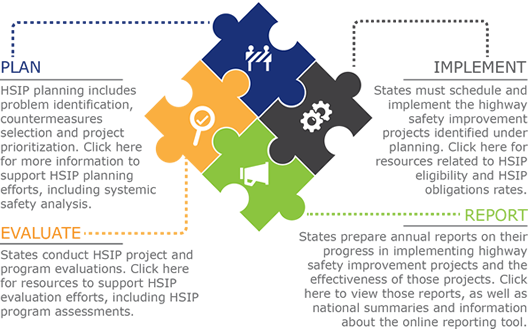U.S. Department of Transportation
Federal Highway Administration
1200 New Jersey Avenue, SE
Washington, DC 20590
202-366-4000
![]() Quality safety data is the foundation of the HSIP planning process. State, regional and local agencies analyze this data to identify potential locations for spot and systemic safety improvements, conduct engineering studies and prioritize highway safety imprvoement projects for implementation.
Quality safety data is the foundation of the HSIP planning process. State, regional and local agencies analyze this data to identify potential locations for spot and systemic safety improvements, conduct engineering studies and prioritize highway safety imprvoement projects for implementation.
Countermeasure Service Life Guide
The purpose of the Countermeasure Service Life Guide is to provide transportation practitioners with the necessary information to make consistent, data-driven decisions for evaluating and prioritizing safety countermeasures using prescribed countermeasure service lives. This Guide provides typical service lives for a wide range of safety countermeasures and demonstrates the benefits to standardizing countermeasure service life application throughout an agency. This Guide also provides background information on factors that can impact countermeasure service life and analytical considerations when conducting benefit-cost analysis for multiple countermeasures or alternatives with differing service life.
Selecting Projects and Strategies to Maximize HSIP Performance
The objective of this guide is to explain how State DOTs, MPOs, and other agencies can use economic analysis methods and safety management approaches to have the greatest potential to reduce fatalities and serious injuries. The guide discusses how projects affect safety performance, presents current approaches for highway safety management, and describes new economic methods and strategies that may improve upon current methods.
Screening Your Network to Improve Roadway Safety Performance – Getting Started
This guide describes network screening in 5 easy steps, with an illustrative example to walk through the process.
Highway Safety Benefit Cost Analysis Guide
The purpose of the Highway Safety Benefit-Cost Analysis (BCA) Guide is to assist transportation agencies in making consistent and sound investment decisions. The target audience includes transportation professionals such as traffic engineers, highway safety engineers, and planners conducting highway safety BCA for projects and programs. This Guide will help these users to quantify the costs, and direct and indirect safety-related benefits of project alternatives. Several resources are available to help you implement the procedures described in the guide:
Crash Costs for Highway Safety Analysis
This guide describes the various sources of crash costs, current practices and crash costs used by States, critical considerations when modifying and applying crash unit costs, and an exploration of the feasibility of establishing national crash unit cost values. This guide proposes a new set of national crash unit costs for the FHWA Highway Safety Benefit-Cost Analysis Guide and Tool as well as procedures to (1) update the crash unit costs over time, and (2) adjust the crash unit costs to States based on State-specific cost of living, injury-to-crash ratios, and vehicle-to-crash ratio.
HSIP Manual
The manual provides guidance to State and local agencies for developing and implementing a highway safety improvement program which best suits their capabilities and needs. The manual should be beneficial to Federal, State, and local highway engineers and other professionals involved in a highway safety improvement program.
HSIP Procedures and Tools Brochure
This brochure describes the Highway Safety Improvement Program (HSIP). The purpose of the HSIP is to achieve significant reductions in traffic fatalities and serious injuries. The brochure describes the HSIP process to achieve these reductions including the four key steps: analyze the data; identify potential countermeasures; prioritize and select projects; and determine effectiveness.
Systemic Approach to Safety
A systemic approach to safety involves widely implemented improvements based on high-risk roadway features correlated with specific severe crash types. This website provides numerous resources, including the Systemic Safety Project Selection Tool, to help agencies adopt, develop and promote systemic safety improvements.
Top 10 Characteristics of a Successful HSIP
This flyer describes HSIP practices and program elements State DOTs should consider adopting to ensure successful implementation of the HSIP.


